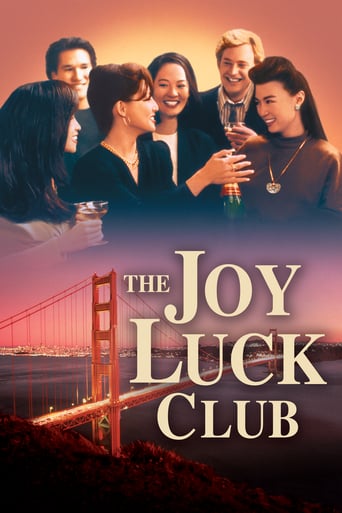peggy77359
One does not have to be Chinese or of Chinese origin to understand, appreciate the film. It simply touches you, no matter what your family background is, where you came from and what language you speak. It is a film of profound sentiments, sentiments between friends, between men and women, mother and daughter and yes, father and daughter, too.I am only sorry that I was not aware of the release of the film and bumped into it by chance only now, 24 years later. Perhaps, I should think that these years have actually enabled me to appreciate it more than 24 years ago when it first came out.Whoever reads the reviews and decides to look for the film should, I'd dare say, can consider himself/herself lucky, as it will make one feels deeper, live more intensely as all lives deserve.
Desertman84
The Joy Luck Club is a film about the relationships between Chinese- American women and their Chinese mothers.It has a cast of Asian-American actresses such as Ming-Na,Rosalind Chao,Lauren Tom,France Nuyen,Tamlyn Tomita,Kieu Chinh,Lisa Lu and Tsai Chin. It is based on the novel of the same title by Amy Tan, who also co-wrote the screenplay with Ronald Bass.The film was directed by Wayne Wang.The film takes place in present-day San Francisco, concentrating on a group of late-middle-aged Chinese women. Ever since arriving in the United States after World War II, the women have gathered weekly to play mah-jongg and to tell stories, regaling each other with tales of their children and grandchildren, giving each other a sense of hope and renewal in the midst of poverty and hardship. The Joy Luck Club is made up of four women -- Suyuan, Lindo, Ying Ying, and An Mei. But when Suyuan dies, the three surviving members invite Suyuan's daughter June to take her place. Along with the daughters of the other members -- Waverly, Lena, and Rose -- June is a Chinese-American with only a passing interest in her rich cultural heritage. But through vignettes that switch back and forth in time, the daughters begin to appreciate the struggles of their mothers to start their families in the optimistic promise of the United States.The movie gives refreshing -- and bittersweet -- dimension to the age- old clash between generations.Four different actresses play the aunties in their youth, which sometimes keeps us struggling to keep the stories straight. That we do is a tribute about the miscommunication that separates one generation from another.Also,it is one of the most touching and moving films ever released on screen that it deserves every tear it wrenches from your eyes.Most of all,it is a great adaptation of a best-selling novel.
jzappa
The story comes after a death and a reunion that bring the past back in all of its undiluted passion, and shows how the present, too, is made, how children who think they are worlds apart are inextricably influenced by the lives of their parents. Wayne Wang's touching film, based on Amy Tan's novel, is about four women, who were born in China and later came to America, and their daughters. Among these eight women mingle countless friends and relatives, to the mise-en-scene's maximum scenery capacity, in peripheral branches of life. Actually, those scenes are the biggest weaknesses of the film, as their interjecting party jest is so transparently scripted that we want only the bottom line of the scenes. But what is about to be dissolved are the beginnings of the women, the stories of how they were born and grew up in a time and culture so far apart from the one in which they live now.The club of the title is a circle of elderly Chinese ladies who meet weekly to play mah jong, and trade stories of their families and grandchildren. All have made ruinous paths from pre- revolutionary China to the privileged homes in San Francisco where they meet. But those old days are not frequently talked about, and often the entire reality of them is not revealed.In a framework of flashbacks, the secrets and stories of all four of the "aunties" are unraveled. We see that the China of the 1930s and 1940s, before the Revolution, was an inconceivably dissimilar world than it is today. Women were not considered too much. Those with resilient spirits and wills were regarded even less than the impressionable, submissive ones. Life was worthless, no more than in wartime. A mother's ability to love her children was doubted. In plenty of instances, all-consuming dilemmas from those hard days still find their echoes in succeeding generations: The potent reality of Amy Tan's story is the lack of understanding between cultures that make the capability of the mothers to identify with their westernized daughters rely on things that have never been clearly vocalized.How, in one instance, could the narrator's mother have told of deserting her first-born twin girls by the roadside? Her mother, ill and emaciated, was certain she should die, and believed her girls would have a better likelihood of living if they were not compromised by the "bad luck" of a deceased mother. Other stories are just as, if not more, agonizing to Americanized ears. There is the auntie who becomes the fourth wife of a wealthy man, and when she gives birth to the son he wished for so much, the child is taken from her by the second wife.In America, the mothers find it difficult to get their minds around the paths their daughters are taking. Some marry whites, who have deplorable etiquette. They move out of the old neighborhood into houses that seem too cutting-edge and frigid. One daughter gives up on ever pleasing her mother, who carps on everything she does.This movie was produced by Oliver Stone, who himself at one time was an astute and scrappy filmmaker who turned out films with cross-cultural themes like this one, such as his Vietnam trilogy, and Joy Luck's director Wang leaves us longing for the rawness of those films, but he captures Tan's story and keeps it pure within his medium. Her story is as respects Chinese and Chinese-American characters, but their stories are all-inclusive. Anyone, everyone, can relate to how the expectations of one generation can become both the obstructions and the awakenings of the next.
ccthemovieman-1
On my first viewing, this film got a "fair" rating because there were not enough memorable roles and the story was confusing to me. I lost track of which person was telling their particular story at the moment. (There are eight stories woven into this two hour, 19 minute movie). I think it would be confusing to most one-time viewers to get confused here if you don't know the stories or the actors. It also got a little soap-opera-ish, too, but then again, this film was based on a best-selling book that was ready primarily by women.On the second viewing, almost two years later, I liked it a lot more and upgraded my "star" rating considerably. It's still a "chick flick" and a feminist one. The young women are that way, the Americanized women, while their mothers, those all born in China, are quite. The older ladies are a bit too strict and their daughters are a bit too liberal. That included general morals and language - a big difference between the two generations and cultures. The feminist angle I didn't like was that in almost every relationship the man is painted as the bad guy (the abuser, the non-loving type, etc.) That kind of story bias was too much.The more memorable of the stories turned out to be the ones with the older women, such as the one who left her two babies at the base of a tree, or the one who had to marry a young boy.For me, the best part of the film was the cinematography. There were some beautiful scenes and great colors: bright oranges, yellows, reds and browns. Some of the young women were beautiful, too. The lady narrating in the beginning, "June" (Melanie Chang as a nine-year- old and then Ming-Na as an adult) was very appealing and had a great voice. Her story is the one that begins and ends the film. That ending, by the way, is almost guaranteed to bring a few tears.Overall, a wonderful visual movie and a great venue for Chinese-American actresses, all of whom I found fascinating to watch.




